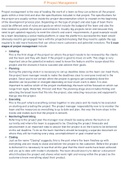Essay
BTEC Level 3 IT Unit 9 Project Management Assignment 1 / Distinction
- Course
- Institution
On this assignment done for unit 9 i have gone in extreme details to cover every part of the assignment and have received a distinction grade!! The points on the assignment covered include: - D1 -Evaluate, using appropriate definitions, the characteristics of different methodologies and structures...
[Show more]



